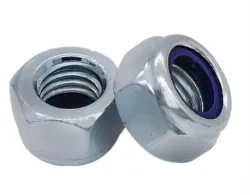DIN934 Hex Nut: The Standard Selection for Industrial Fasteners
Août . 18, 2025 14:18 Retour à la liste
DIN934 Hex Nut: The Standard Selection for Industrial Fasteners
In the field of industrial fastening, DIN934 Hex Nut, as a widely used standard component, has become an important component for connecting bolts, ensuring equipment and structural stability with its standardized size parameters and reliable fastening performance.

The structural design of DIN934 Hex Nut follows strict German industrial standards and has distinct normativity
Hex nuts have a regular hexagonal shape with six evenly distributed edges, making it easy for tools such as wrenches to apply force and providing stable torque during the tightening process. The thread accuracy inside the nut is extremely high, and the pitch and tooth profile strictly meet the standards, which can perfectly match with bolts of the same specification to form a tight connection. This standardized structural design ensures good interchangeability of DIN934 Hex Nut produced by different manufacturers, providing great convenience for assembly and maintenance in industrial production.
The optimization of material and performance is the core of DIN934 Hex Nut's effectiveness
Hex nuts are usually made of high-quality carbon steel, stainless steel, and other materials. Carbon steel nuts have high strength and hardness after heat treatment, and can withstand large loads; Stainless steel material has excellent corrosion resistance and is suitable for harsh environments such as humidity and dust. In addition, DIN934 Hex Nut used in some special scenarios will undergo surface treatment, such as galvanizing, chrome plating, etc., to further enhance its rust prevention ability and service life, ensuring stable fastening effect during long-term use.
DIN934 Hex Nut is widely used in the industrial field
In mechanical manufacturing, it is used in conjunction with bolts to fix the components of machine tools and ensure the stability of equipment operation; In construction engineering, it is commonly used for connecting steel structures, firmly fixing steel beams, columns, etc. to ensure the safety of the building structure; In automobile manufacturing, its presence can be seen from the engine to the body components, providing a secure guarantee for the safe driving of the car. Whether it is heavy industrial equipment or precision instruments, DIN934 Hex Nut meets various fastening needs with its reliable performance.
With the development of industrial technology, the production and performance of DIN934 Hex Nut are constantly improving
High precision machining equipment is introduced in the production process to ensure the accuracy and consistency of threads, making the fit between nuts and bolts tighter and reducing the risk of loosening. In terms of materials, the application of new alloy materials has made significant breakthroughs in the strength and corrosion resistance of nuts, enabling them to adapt to more complex working environments. At the same time, the implementation of intelligent production mode has improved production efficiency and product quality stability, enabling DIN934 Hex Nut to better meet the high standard requirements of modern industry.
In summary, DIN934 Hex Nut occupies an important position in the industrial fastening field due to its standardized structure, high-quality material performance, wide application scenarios, and continuous technological upgrades. Although compact, it plays a crucial connecting role in countless industrial products and engineering projects, ensuring the stable operation of equipment and structures. In the future, with the continuous development of industry, DIN934 Hex Nut will continue to pursue innovation on the basis of standardization, providing more reliable support for industrial fastening.
DIN934 Hex Nut FAQs
What is the DIN934 Hex Nut standard?
DIN934 is a hexagonal nut standard developed by the German Institute for Standardization (DIN), which specifies the dimensions, tolerances, and technical requirements of metric threaded nuts and is widely used in the fields of mechanical manufacturing and construction.
What are the materials for DIN934 Hex Nut?
Common materials include carbon steel (such as 4.8 grade, 8.8 grade), stainless steel (such as A2-70, A4-80), and brass. Surface treatment options include galvanizing, blackening, or Dacromet anti-corrosion processes.
What is the difference between DIN934 Hex Nut and GB/T6170 nuts?
Both are standard hex nuts, but DIN934 is a German standard and GB/T6170 is a Chinese national standard. The main differences lie in dimensional tolerances and chamfer details, and some specifications are interchangeable in actual use.
How to label the specifications of DIN934 Hex Nut?
The annotation should include thread specifications, edge width, and standard number, for example, "M10 DIN934" represents a hexagonal nut with a nominal diameter of 10mm that complies with DIN934 standards.
What is the anti loosening performance of DIN934 Hex Nut?
Ordinary DIN934 Hex Nut has no anti loosening design and needs to be equipped with spring washers or nylon inserts (such as DIN985) to prevent loosening. It is recommended to use flange nuts or eccentric nuts in vibration environments.
Dernières nouvelles
-
Bolts for Lawn Mower Handle Supplier | OEM & Rust-Resistant
NouvellesNov.17,2025
-
Silver Screws Supplier | Corrosion-Resistant, Bulk & Custom
NouvellesNov.17,2025
-
Cabinet Bolts Supplier | OEM, Bulk Stock, Fast Shipping
NouvellesNov.17,2025
-
Axle Nuts Supplier - OEM-Grade, ISO-Certified, Fast Delivery
NouvellesNov.17,2025
-
Wire Bolts Suppliers – OEM Factory Prices, ISO Quality
NouvellesNov.11,2025
-
Bolts for Lawn Mower Handle Supplier – OEM & Anti‑Rust
NouvellesNov.11,2025
